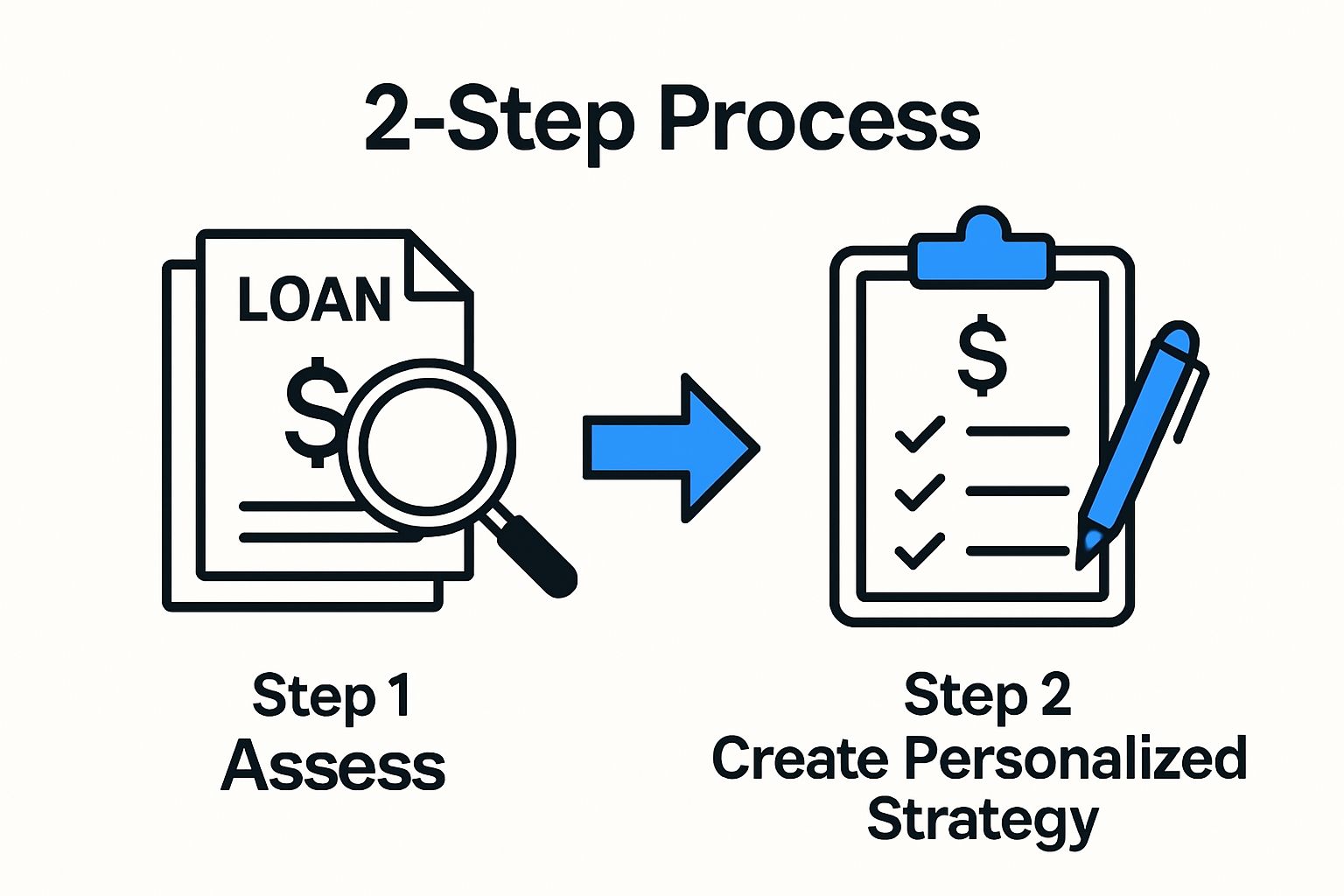Student loans can feel overwhelming fast. The numbers grow and options stack up until it all blends together. Here is the surprising part. About 43 million americans carry student debt totaling over $1.7 trillion, but most people have no clear plan to get rid of it. Having a roadmap—rather than just crossing your fingers—can turn that mountain of debt into a series of manageable steps you can actually control.
Table of Contents
- Step 1: Assess Your Total Student Loan Balance
- Step 2: Research Available Repayment Plans
- Step 3: Create A Personalized Payment Strategy
- Step 4: Implement Your Payment Plan
- Step 5: Monitor Progress And Adjust As Necessary
Quick Summary
| Key Point | Explanation |
|---|---|
| 1. Assess your total loan balance | Gather all your loan documents to understand the full extent of your student debt. This includes federal and private loan details. |
| 2. Explore repayment plans | Research different repayment options based on your financial situation. Federal loans offer more flexibility than private loans. |
| 3. Create a personalized payment strategy | Develop a plan that prioritizes high-interest loans and utilizes methods like the debt avalanche or snowball approach. |
| 4. Implement automatic payments | Set up automatic payments with your loan servicers to ensure timely contributions and possible interest rate reductions. |
| 5. Regularly monitor and adjust your strategy | Establish a monthly review routine to track progress and adjust your payment strategy based on changes in income or expenses. |
Step 1: Assess Your Total Student Loan Balance
Managing student loan debt begins with understanding exactly what you owe. Most borrowers underestimate their total student loan balance, which can lead to misguided financial strategies. To kickstart your debt management journey, you need a comprehensive snapshot of your entire educational debt landscape.
Start by gathering all your loan documents from every potential source. This means tracking down federal student loans through the National Student Loan Data System, private student loans from individual bank statements, and any additional educational credits you might have accumulated. Compile all documentation in one secure digital folder to create a complete financial picture.
Accurately calculating your total student loan debt requires methodical investigation. Log into each loan servicer’s website and download recent statements. Federal loans can be tracked through the Federal Student Aid website, while private loans will require checking with individual financial institutions. Pay close attention to current balance, interest rates, and repayment status for each loan.
For federal loans, you’ll want to note whether they are subsidized or unsubsidized, as this impacts how interest accrues. Private loans often have different terms and might include variable interest rates that can significantly impact your long-term repayment strategy. Our guide on managing credit card debt can provide additional insights into tracking complex financial obligations.
Verification is crucial in this process. Create a detailed spreadsheet or use a reputable loan tracking app to document:
- Total principal balance
- Current interest rates
- Monthly payment amounts
- Loan servicer contact information
- Repayment status (in deferment, forbearance, or active repayment)
By the end of this step, you should have a crystal clear understanding of your total student loan debt.
Here is a checklist to confirm you have all the necessary information to accurately assess your total student loan balance before moving on to repayment strategies.
| Item to Verify | Description | Verification Method |
|---|---|---|
| Federal loan balances | Current principal and interest rates | Access through Federal Student Aid website |
| Private loan amounts | Outstanding balance, interest rate, variable/fixed | Check statements from each private lender |
| Loan servicer contacts | Name, website, and service phone number | Reference loan documentation |
| Repayment status | Active, deferment, or forbearance status | Review each account online |
| Loan type (subsidized, etc.) | Subsidized, unsubsidized, or other (for federal loans) | Identify in official loan records |


Step 2: Research Available Repayment Plans
After identifying your total student loan balance, the next critical step is exploring repayment strategies that align with your financial situation. Not all repayment plans are created equal, and selecting the right approach can dramatically reduce financial stress and potentially save thousands of dollars over the loan’s lifetime.
Federal student loans offer multiple repayment options, each designed to accommodate different income levels and financial circumstances. Income-Driven Repayment (IDR) plans provide flexibility by adjusting monthly payments based on your earnings. These plans include options like Pay As You Earn (PAYE), Revised Pay As You Earn (REPAYE), Income-Based Repayment (IBR), and Income-Contingent Repayment (ICR).
Private student loans typically have fewer flexible repayment options compared to federal loans. However, many private lenders now offer alternative payment structures that can help borrowers manage their debt more effectively. Contact your private loan servicers directly to understand their specific repayment alternatives. Some might offer temporary forbearance, interest-only payments, or graduated repayment schedules that can provide short-term financial relief.
Key considerations when evaluating repayment plans include:
- Your current annual income
- Potential future earning trajectory
- Total loan balance
- Interest rates on individual loans
- Long-term financial goals
For comprehensive financial planning, our budgeting guide can help you integrate student loan repayment into a broader financial strategy. Remember that choosing a repayment plan is not a one-time decision. As your financial situation evolves, you can typically switch plans to better match your current circumstances.
To complete this step, schedule consultations with your loan servicers and compile a detailed comparison of available repayment options. Document the pros and cons of each plan, focusing on monthly payment amounts, total interest paid, and potential loan forgiveness opportunities.
Below is a comparison of common federal student loan repayment plans to help you evaluate which option aligns best with your financial situation.
| Repayment Plan | Monthly Payment Basis | Eligibility | Key Features |
|---|---|---|---|
| Standard Repayment | Fixed over 10 years | All borrowers | Fastest payoff, highest monthly payment |
| Graduated Repayment | Low at first, increases | All borrowers | Payments start low and increase every 2 years |
| Income-Based Repayment | 10-15% of discretionary | Qualifying | Adjusts to income, loan forgiveness possible |
| Pay As You Earn (PAYE) | 10% of discretionary | Qualifying | May lower payment, forgiveness after 20 years |
| Revised Pay As You Earn (REPAYE) | 10% of discretionary | All Direct loan borrowers | Spousal income included, forgiveness 20-25 years |
Step 3: Create a Personalized Payment Strategy
With a comprehensive understanding of your student loan landscape, it is time to craft a strategic payment approach tailored to your unique financial situation. A personalized payment strategy goes beyond making minimum monthly payments and focuses on efficient debt reduction while maintaining overall financial health.
Prioritize your loans strategically by focusing on high-interest debt first. This typically means targeting private loans or federal unsubsidized loans that accumulate interest more quickly. By allocating extra funds to these high-cost loans, you can significantly reduce the total interest paid over the loan’s lifetime. Calculate the potential savings by using online loan repayment calculators that demonstrate different payment scenarios.
Consider implementing a targeted repayment method such as the debt avalanche or debt snowball approach. The avalanche method involves paying minimum amounts on all loans while directing additional funds toward the highest interest rate loan. The snowball method focuses on paying off the smallest balance first, creating psychological momentum. Our financial planning guide offers additional insights into structuring effective debt reduction strategies.
Automate your payment process to ensure consistency and potentially qualify for interest rate reductions. Many loan servicers offer a small interest rate discount (typically 0.25%) for setting up automatic payments. This not only simplifies your financial management but can save hundreds of dollars over the loan’s duration.
Key elements to include in your personalized payment strategy:
- Monthly payment amount above the minimum requirement
- Specific allocation of extra payments
- Automatic payment setup
- Quarterly review and adjustment of strategy
- Emergency fund to prevent missed payments
Remember that a personalized payment strategy is not static. Regularly reassess your approach as your income changes, career progresses, or financial circumstances shift. The goal is to create a flexible plan that adapts to your evolving financial landscape while consistently reducing your student loan burden.
To verify the effectiveness of your strategy, track your loan balances monthly and calculate the projected payoff date. Celebrate milestones along the way to maintain motivation and financial discipline. Your personalized approach transforms student loan management from a overwhelming challenge into a structured, achievable financial goal.
Step 4: Implement Your Payment Plan
Transitioning from strategy to action, implementing your student loan payment plan requires precision, commitment, and a systematic approach. This crucial step transforms your carefully crafted strategy into tangible financial progress, turning complex loan management into a straightforward, executable process.
Set up automatic payments through your loan servicers to ensure consistent, timely contributions. Automatic payment systems not only simplify your monthly financial routine but often provide interest rate reductions as an added incentive. Contact each loan servicer to establish these automatic transfers, verifying the exact date funds will be withdrawn and confirming the allocation matches your strategic plan.
Track your payments meticulously by creating a dedicated spreadsheet or using personal finance applications that can monitor multiple loan accounts simultaneously. Allocate any additional funds strategically, directing extra payments toward high-interest loans first. This approach minimizes long-term interest accumulation and accelerates your overall debt reduction timeline.
Develop a financial buffer to prevent potential payment disruptions. Maintain an emergency fund that covers at least two to three months of potential loan payments. This safety net protects your credit score and prevents unexpected financial setbacks from derailing your carefully constructed repayment strategy. Our guide on financial stress management offers additional insights into creating financial resilience.
Critical implementation steps include:
- Confirm automatic payment setup with each loan servicer
- Verify correct payment allocation
- Set calendar reminders for manual review of payments
- Monitor credit report for accurate loan reporting
- Adjust strategy quarterly based on financial changes
Regularly review your payment plan’s performance, looking for opportunities to optimize. Some borrowers might find refinancing beneficial, while others could explore loan forgiveness programs or additional income streams to accelerate repayment. The key is maintaining flexibility and proactive financial management.
Success in this step means establishing a reliable, consistent payment system that aligns with your broader financial goals.
By transforming your strategy into action, you’re not just managing student loan debt you’re building a foundation for long-term financial freedom.
Step 5: Monitor Progress and Adjust as Necessary
Managing student loan debt is a dynamic process that requires continuous attention and strategic adaptation. This final step focuses on creating a robust system for tracking your progress, identifying potential improvements, and maintaining financial flexibility as your life circumstances evolve.
Establish a monthly review routine that goes beyond simply checking your loan balance. Comprehensive loan progress monitoring involves analyzing payment impacts, interest accumulation, and alignment with your overall financial goals. Set aside dedicated time each month to review your loan statements, verify payment allocations, and assess your current repayment strategy’s effectiveness.
Utilize digital tools and financial tracking applications to streamline your monitoring process. Many modern financial apps can aggregate loan information from multiple servicers, providing a comprehensive view of your debt reduction journey. Look for platforms that offer visual representations of your progress, such as debt payoff graphs or projected payoff timelines. These visual aids can be incredibly motivating and help you stay committed to your financial objectives.
Prepare to make strategic adjustments based on significant life changes. Career advancements, income increases, or unexpected financial windfalls present opportunities to accelerate your student loan repayment. Our financial planning resources can help you navigate these transition periods effectively.
Key monitoring and adjustment considerations include:
- Quarterly comprehensive loan strategy review
- Tracking total interest paid versus principal reduction
- Evaluating potential refinancing opportunities
- Assessing eligibility for loan forgiveness programs
- Updating payment strategy with income changes
Develop a proactive approach to potential challenges. If you anticipate difficulty making payments due to job loss or reduced income, contact your loan servicers immediately to explore deferment, forbearance, or income-driven repayment options. Maintaining open communication prevents negative credit impacts and demonstrates financial responsibility.
Successful monitoring means transforming your student loan management from a reactive task to a strategic financial practice. By consistently reviewing, analyzing, and adapting your approach, you create a personalized debt reduction system that evolves with your financial journey. Remember, managing student loan debt is not about perfection but about consistent, intentional progress toward your ultimate financial freedom.
Take Control of Your Student Loan Debt with Personalized Financial Guidance
Are you struggling to understand your full student loan picture or feeling overwhelmed by complicated repayment options? If the steps in our article helped, but you still worry about missing important details or making costly mistakes, you are not alone. Many borrowers face frustration with tracking multiple loans, selecting repayment plans, and trying to fit payments into a tight budget. You deserve more than generic advice—what you need is a strategy tailored to your unique goals and financial situation.
At finblog.com, our expert team specializes in building customized solutions for real problems like yours. Learn how to transform the insights from our financial planning guide and discover actionable budgeting tips from our budgeting guide that let you make real progress. Ready to put yourself in control of your student loans? Visit finblog.com today and take the first step toward a confident financial future. Connect with us now for expert guidance that fits your life.
Frequently Asked Questions
What is the first step in managing student loan debt?
Managing student loan debt begins with assessing your total student loan balance. This involves gathering all loan documents, tracking down federal and private loans, and compiling a complete financial picture to understand what you owe.
How can I find repayment plans for my federal student loans?
Federal student loans offer multiple repayment options including Income-Driven Repayment (IDR) plans. You can explore these options on the Federal Student Aid website, which details various plans based on your income and financial circumstances.
What strategies can I use to create a personalized payment plan for my student loans?
To create a personalized payment plan, prioritize loans by interest rates, consider using the debt avalanche or snowball method, and automate payments. Additionally, ensure to allocate extra funds toward high-interest loans and regularly re-evaluate your strategy as your financial situation changes.
How often should I monitor my student loan repayment progress?
It’s advisable to conduct a monthly review of your student loan repayment progress. This includes checking loan balances, verifying payment allocations, and assessing the overall effectiveness of your repayment strategy to make necessary adjustments as your financial situation evolves.
Recommended
- Master Managing Credit Card Debt: Achieve Financial Freedom – Finblog
- Effective Financial Stress Management for a Secure Future – Finblog
- What is a Financial Plan? Understanding Its Importance – Finblog
- How to Manage Debt: Proven Steps for Financial Freedom – Finblog
- 7 Smart Personal Finance Strategies for Everyday Success | Prodcast










